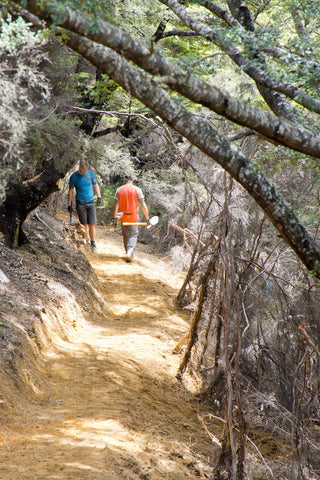Your Cart is Empty
Gear
FAQ
Blog
The Trail Builders' Rough Guide
01 October 2014
Each night before bed all good trail builders bow their heads and mumble something along the lines of "I will build sustainable trails". Come morning this translates to designing and constructing fabulous singletrack that will require only minimal maintenance regardless of rainfall and volume of riders. The International Mountain Bike Association (IMBA) produces a bible called 'Trail Solutions' for building such tracks. The 'rules' mostly focus on maximum steepness of the track, which in general terms is determined by the side slope of the hill you are on (nothing is ever flat), soil type, rainfall, volume of users, and technical difficulty.

Follow their tried 'n' tested techniques and the resulting track suffers no drainage issues and will flow like gravy on ya spuds - without needing sudden or aggressive braking to tackle corners or trail features. Get the gradient right and drainage is handled with 'out-sloping' so water sneaks over the downhill edge rather than using an old school 'gutter' with culverts or water bars. Drainage is further managed with a trail feature called grade reversals. Think a wide open dip where the track briefly heads back uphill to divert any residual water flowing down the track. Placed intelligently a grade reversal can be used to scrub off speed before a corner or a steeper pitch of the trail.

Back in the real world we have a mixture of modern 'sustainable trails' and legacy tracks that predate this wisdom. Christchurch's Port Hills boasts a well planned and extensive trail network. But back in 1995 neither the land managers nor mountain bike advocates had forecast the current huge volume of users. Nor were the truly unique and fragile soil types fully understood. Now track maintenance is a substantial issue in some areas. Port Hills' Ranger Nick Singleton talks enthusiastically about the learning curve and how to tweak the existing tracks with re-surfacing and re-aligning hairpin corners to better suit the current use. All new tracks are subject to a whole different design criteria - expensive up front but a stitch in time 'n' all that.

Club driven projects in exotic forest elsewhere in the country have a more flexible mandate, with the caveat of being subject to a commercial forest life-cycle. The Rotorua Mtb Club has more experience than most with their renowned singletrack in Whakarewarewa Forest. They successfully petitioned the local council to buy the logging rights - preserving the trees and the trails within. However the rules of engagement have recently changed with new landowners placing a moratorium on all trail building and maintenance. Jeff Carter, trail builder and past president, serves up this advice for clubs or groups with their eye on an unfettered slice of forestry... "there are two windows for developing trails in a commercial forest - after the clear-fell harvest and then 10-15 years later after the first thinning. It's important to establish an agreement with the forest manager at the outset, stating that you won't contest the harvest based on the recreational value of the trail network and allowing for new tracks to be built soon after logging."
Makara Peak has a strong conservation ethos. The 200 hectares of public land has over 25kms of volunteer built shared-use tracks that mimic backcountry trails, but within Wellington's city limits. The Makara Peak Supporters have planted over 30,000 native trees. Combined with active pest and weed control, the community has gained a valuable restored environment with on-going trail access guaranteed.

Volunteer passion and toil is pivotal to any project. But is invariably supplemented with cash for materials and equipment. Community Trusts, local businesses, the Backcountry Trust, Trail Fund NZ and of course the Ground Effect Slush Fund are all worthwhile hitting up for dollars.
In New Zealand, the Department of Conservation now actively pursues partnerships for track construction and maintenance. The Mtb Trails Trust with their Epic Trails plan for the Nelson area and the Craigieburn Trails' network are shining examples of what can be achieved when DOC actively supports local advocates to develop new tracks. 8000 people ride the Hog's Back at Craigieburn each summer. In DOC terms that makes it a 'very popular and valuable asset'.
Much has been learned over the past decade. There are plenty of success stories in both New Zealand and Australia. And the key players have skills and experience that they are willing to share. A great starting point though is IMBA's excellent trail building book - 'Trail Solutions'. So far Ground Effect have gently placed a couple of hundred copies in the hands of Slush Fund projects on both sides of the Tasman. If your club or organisation is involved in trail work, then talk to us at slushfund@groundeffect.co.nz about getting your hands on a copy.
Dig deep... and enjoy some video fun.
UnderGround email List
Join our UnderGround newsletter for regular updates from our blog, new product releases and hot deals.
UnderGround email List
Join our UnderGround newsletter for regular updates from our blog, new product releases and hot deals.
